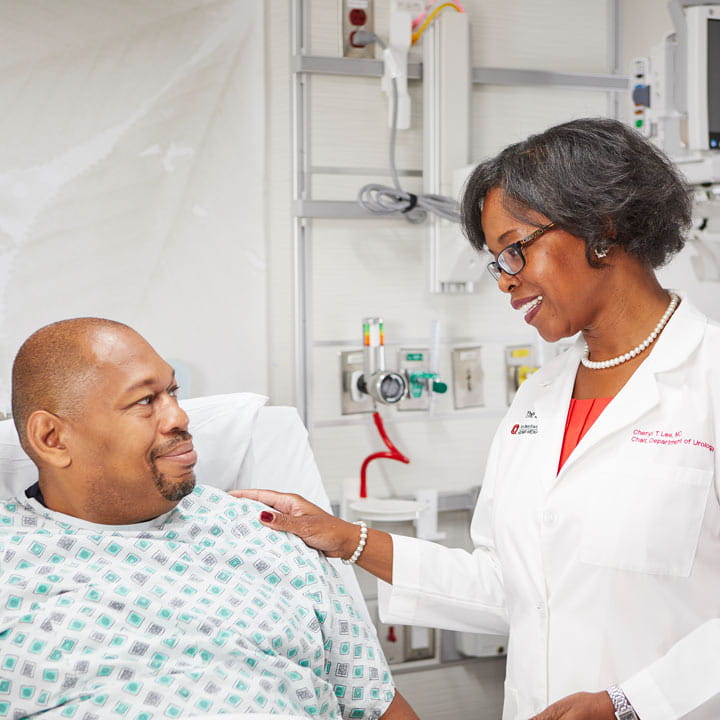 Health disparities in genitourinary (GU) cancers are well documented. At The Ohio State University Wexner Medical Center, they’re getting attention. For more than five years, the GU oncology care team has engaged in multifaceted efforts to reduce these disparities and improve care outcomes.
Health disparities in genitourinary (GU) cancers are well documented. At The Ohio State University Wexner Medical Center, they’re getting attention. For more than five years, the GU oncology care team has engaged in multifaceted efforts to reduce these disparities and improve care outcomes.
“We want to ensure we’re delivering excellent care and providing the right support to all of our patients,” says Cheryl Lee, MD, the Dorothy M. Davis Chair in Cancer Research in The Ohio State University College of Medicine’s Department of Urology and vice president of OSU Physicians, Inc., and the Faculty Group Practice.
Improving access and reducing barriers
Improving access to care is a key area of focus. Some of the ways the team is doing that include:
- Improving access to physical locations. This July, the Ohio State Wexner Medical Center opened The James Outpatient Care on the university’s West Campus. It provides a one-stop shop for patients with GU cancer by bringing together experts from urologic oncology, medical oncology and radiation oncology, as well as our clinical trials support team. We also perform outpatient surgeries for prostate, bladder and kidney cancer at this location.
“We know that many patients avoid our main campus because of the challenges that come with navigating a large system, including parking,” Dr. Lee says. “The new facility is truly patient-friendly, with close parking and accessible clinics and operating room suites.” - Increasing access to clinical trials. Through a $3.5 million grant from the National Cancer Institute, Dr. Lee and co-principal investigator Electra Paskett, PhD, MSPH, will be working to identify and improve barriers to clinical trial participation faced by underrepresented populations. Dr. Paskett is director of the Division of Cancer Prevention and Control at Ohio State and director of the Center for Cancer Health Equity at The Ohio State University Comprehensive Cancer Center – Arthur G. James Cancer Hospital and Richard J. Solove Research Institute. Their study is titled, “Connecting Underrepresented Populations to Clinical Trials” (CUSP2CT) project.
“With access to novel therapeutics and frequent medical visits, patients generally have better disease and survival outcomes when they’re part of clinical trials,” Dr. Lee says.
What’s more, correlative science using tissue samples of trial participants is often used to generate hypotheses for extended work, including drug development.
“Most of us believe that diversity in molecular datasets will lead to better treatments addressing the potential heterogeneity that exists across various populations,” Dr. Lee says. - Increasing use of telehealth and other technology-based endeavors. Kamal Pohar, MD, and colleagues, for example, are studying bladder cancer progression in rural Ohio and the feasibility of using telehealth to help manage the disease and survey treated patients.
Providing patient-centered care
Increasing provider diversity may also help put people at ease and is a cornerstone of patient-centered care. It’s also something Dr. Lee champions personally.
“We want our faculty to reflect the patients we serve and, certainly, the learners whom we usher into the field,” Dr. Lee says.
Nationally, only about 11% of urology practitioners are women. But at the Ohio State College of Medicine, roughly one-third of the urology faculty are female. And currently, about 30% of urology residents are women. It’s quite a change from just seven years ago, when there was just one female resident. People of different races, national origins, sexual identities and other demographics are included among the learners and faculty, as well.
Providing patient-centered education is yet another way to address disparities. Shawn Dason, MD, is working to improve prostate cancer outcomes in African American men by increasing awareness of the disease and the importance of screening. He regularly attends community events to educate those at high risk.
In addition, Michael Gong, MD, PhD, has created free web-based educational videos about surgical treatments for prostate cancer that may ultimately make it easier to seek care. The videos cover a variety of topics ranging from surgical preparation to sexual rehabilitation. Additional information is offered through Ohio State MyHealth, the Wexner Medical Center’s mobile app.
“Hopefully, this will help allay some of the concerns patients have when they think about major surgery for prostate cancer,” Dr. Lee says.
Looking ahead
Ending disparities won’t happen overnight. But it’s possible with commitment. And that’s one area where the Ohio State College of Medicine and the Wexner Medical Center shine. The entire urology team is working to make it happen.
“We want a culture that’s inviting for all,” Dr. Lee says.

